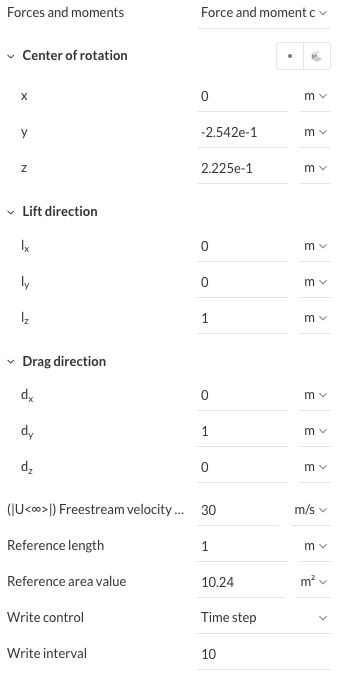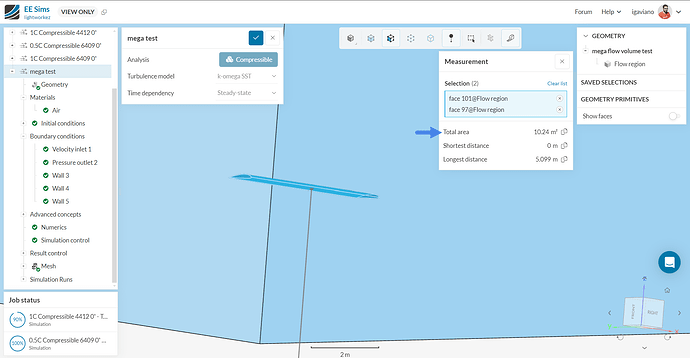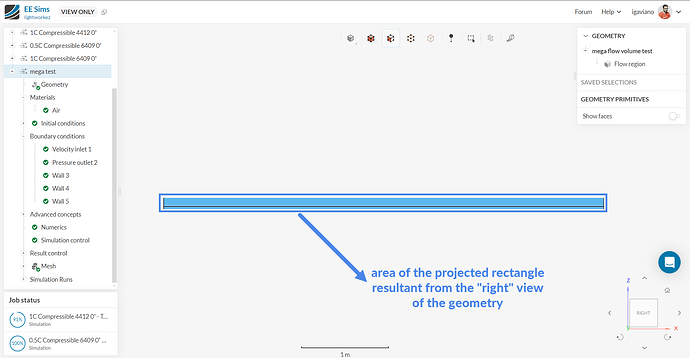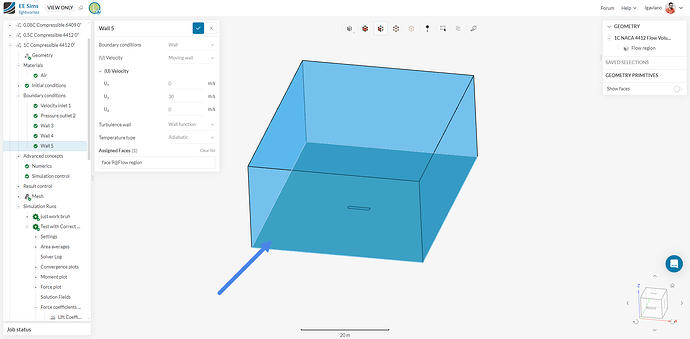Hi,
I’m trying to simulate airfoil performance under the ground effect. The lift coefficients seem pretty close to what I’ve seen in other literature, but the drag coefficients are off by almost exactly an order of magnitude (e.g. 0.105 instead of 0.0142).
I’m not sure why this is the case; I’ve set the center of rotation as ~25% of chord length as suggested online, and I’ve set the reference area to the surface area of the top surface of the wing.
Is there something else I’m missing?
Project link: SimScale Login
Hi @lightworkez, thanks for posting on the forum and welcome to the SimScale Community 
It seems like you’re using the total area of the wing to calculate the coefficients. Usually for this application, the frontal projected area is used instead, as mentioned in the following knowledge base article:
Note that different values for the reference area are also usually applied depending on which coefficient you’re interested in measuring.
As a sidenote, I’ve noticed that your project is private. Can we share screenshots of it if further discussion is necessary?
Best,
Igor
Hi, I made two different “forces and moments coefficients” objects to calculate drag and lift separately.
Interestingly, the drag coefficient calculated using total wing area area is more accurate (closer to literature) than that calculated using the frontal wing area; and the lift coefficient is more accurate when calculated using the frontal wing area.
Below is a screenshot of the settings I’ve used to calculate lift coefficient; does anything seem off to you? From what I understand, reference length is supposed to be chord length, correct?
Also - I’m not sure why I can’t make public projects; I think my account type can only make private projects. What screenshots should I share?
Hi @lightworkez,
Starting from your last comment:
Since your account is academic, you aren’t able to create public projects in the platform as of now. However, I can see your project since it’s shared with support - my question was more due to possible a privacy concern from your end (to know if I could share the screenshots myself here).
As to your questions:
- The area seems to be the sum of the upper/lower parts of the wing:
whereas I guess it should be something more like this:
- As to the reference lenght, you don’t need to worry about it for now. It’s not used in the calculation of the coefficients.
Does that help?
Best,
Igor
Hi Igor,
Sorry, I don’t think I explained very well.
I found the frontal projected area of the NACA 4412 to be 0.642 meters and the total wing area to be 10.24 meters.
I want to obtain the drag and lift coefficients from the same simulation run, so I created two separate “forces and moments coefficients” objects; one with total wing area (to calculate lift coefficient) and another with frontal projected area (to calculate drag coefficient). In the screenshot I included, I only showed the “forces and moments coefficients” settings for the lift coefficient, hence why I’m still using 10.24 meters.
The issue I’m currently having is that despite using the correct surface area measurements (see simulation “1C Compressible 4412 0˚” for my settings), the coefficients still seem to be incorrect. The total wing area provides the correct drag coefficient and incorrect lift coefficient; and the frontal projected area provides the correct lift coefficient but incorrect drag coefficient (see Simulation Run “Test with Correct Reference Areas” under “1C Compressible 4412 0˚” for the results I’m referring to).
I’m not sure why this is occurring - can you see if anything else is wrong with my settings?
Thanks,
Maako
Hi @lightworkez,
Thanks for the reply. The only thing I’ve found off with your simulation is this:
Since physically it would be like a rigid floor moving - are you simulating the aiplane still on the ground? If the plane is in the air, it seems like it would be more fitting to set it as a slip wall.
As a sidenote, I don’t think you should use the toal wing area for the coefficients - did you see it being used somewhere? Also, this portion of the article I’ve shared also highlights that sometimes different values for the reference are are more suited to calculate the lift/drag coefficients, that might be the reason why you’re getting better values when using different ones.
Best,
Igor
1 Like



